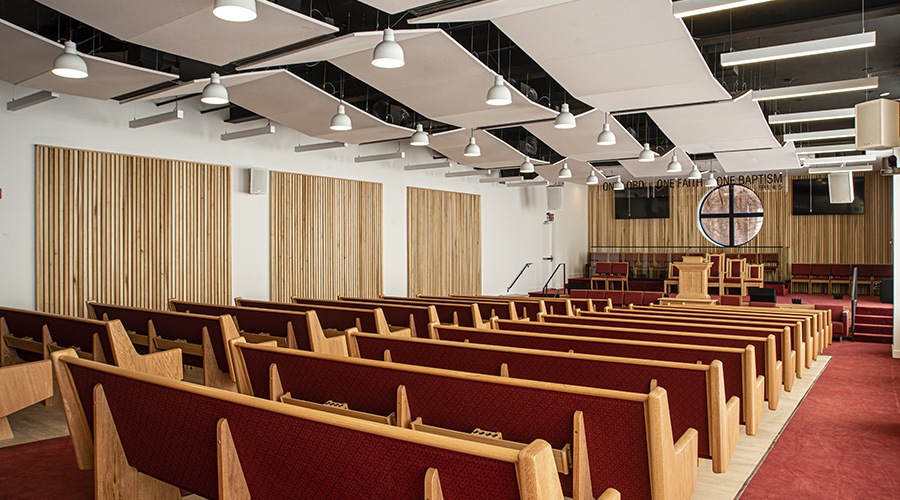Does Your Facility Hit its Energy Target?
New LEED buildings claim significant energy savings over code. But few are measuring to verify whether they meet their goals
By Naomi Millán, Associate Editor
Seattle’s new City Hall was supposed to be a model of energy efficiency when it was completed in 2005. But so far the new facility hasn’t lived up to its advance billing.
Critics of the building note that the old building was larger and held more employees, yet used less energy. Defenders of the building say the comparison with the old City Hall is unfair because the two buildings are so different. The new building, they point out, has an atrium and special ventilation requirements that make it inherently more energy intensive.
In all this back and forth, both sides agree on this point: After the building was completed, no one checked to see whether the new City Hall was hitting the energy targets that helped it win LEED Gold certification. Only after published reports called the building’s energy performance into question was an energy audit scheduled.
There were plenty of things for an auditor to find. Problems existed with the underfloor air-distribution system and setpoints. And new operations and maintenance procedures were misunderstood.
A report scheduled for release later this year aims to show that the building’s energy use has been brought back in line with its design intent. But even if energy performance is on track, the question remains: How long would the energy problems have persisted if the building hadn’t fallen prey to bad publicity?
There is evidence that Seattle’s City Hall is far from the only green building that is falling short when it comes to checking on energy performance. A new study suggests that many green buildings are less energy efficient than they were designed to be — and that few are taking steps to find out what their energy performance actually is.
The new study — released in March by the New Buildings Institute — examined the energy performance of buildings certified under the LEED for New Construction (LEED-NC) rating system. The study found that while roughly 48 percent of buildings were exceeding their energy targets, about 42 percent fell short. Energy use intensity was also inconsistent, ranging from less than 20 to more than 120 kBtu per square foot. A number of buildings in the study even failed to perform to code.
The report concluded that LEED-NC buildings are more energy efficient than average buildings. But better feedback on actual energy performance is needed — and so is better follow-up if that feedback shows the building is missing its energy targets.
The reasons for the general failure to measure and verify energy use are complex. Reputations, revenues and rampant finger-pointing all have a part to play. And while experts differ on whether measurement and verification needs to be complex or can be as simple as closely reading energy bills, everyone agrees that what isn’t measured can’t be managed.
LEED-NC Energy Performance
The U.S. Green Building Council’s LEED rating system is the most widely accepted standard for green buildings. The latest version of the flagship LEED program — LEED for New Construction and Major Renovations, version 2.2 — requires all LEED-NC buildings to show that they are designed to be at least 14 percent more efficient than the energy performance requirements of ASHRAE 90.1-2004. That requires a software model to assess the energy performance of the design. (A new version of LEED — LEED 2009 — is currently being developed and will be released next year.)
Using models to predict energy performance is necessary in buildings that have not yet been able to gather actual data, though models pose their own problems. (See “The Limits of Energy Models” on facing page.) The real test of a building’s energy efficiency comes after the doors are opened.
To investigate the energy performance of LEED-NC buildings, USGBC commissioned the New Buildings Institute to do a study of the 552 LEED-NC version 2 buildings certified through 2006 to find out just how they were doing. Of the 552 buildings, only 121 participated in the study. The sole requirement for participation was that a building had to provide at least one full year of measured post-occupancy energy use data.
The good news is that the buildings in this self-selected sample are saving energy compared to typical buildings. The energy intensity of buildings in the survey was 24 percent less than buildings in the Commercial Building Energy Consumption Survey (CBECS). CBECS is a national survey of building characteristics compiled every four years by the federal Energy Information Administration.
The bad news is that the energy performance of individual LEED buildings in the study is all over the board. For example, only about 11 percent of buildings actually performed to their designed energy-use intensity. In an extreme case, a building that was designed with an intensity of around 95 kBtu/sf measured at more than 120 kBtu/sf — that’s 26 percent over the target.
Energy performance isn’t the only way that buildings in the sample fall short of design goals. Even though more than 40 percent of the projects achieved the LEED Measurement and Verification credit and had been operational for at least a year, only three projects used the measurement and verification process as part of their actual performance documentation. The Measurement and Verification credit, the Additional Commissioning credit and the Daylight and Views credit, all intended to help energy efficiency, were not linked to improved energy performance, the study found.
According to Cathy Turner, a senior analyst with the New Buildings Institute study, most buildings had not been monitoring energy use and found it difficult to get 12 months of data together. Speaking of the energy management plan that is required to achieve the Measurement and Verification credit, Turner says, “LEED-NC is earned before energy experience is known. They had to submit a plan, which doesn’t mean they followed the plan.”
Of the 47 projects so far certified under LEED version 2.2 — the most stringent in terms of energy efficiency — only 47 percent, or 22, have earned the Measurement and Verification credit. In this regard, these exceptional projects are following very average trends. Of the last roughly 30 projects he has retrocommissioned, only two were measuring for energy use, says Howard McKew, director of RDK Building Solutions Group. Measurement and verification is rare in building design and operations, for a whole host of reasons.
Roadblocks to Measurement and Verification
On the surface, there would seem to be a very simple reason why measurement and verification never gets very high on the to-do list for facility executives, design engineers and others: Money.
“It’s purely dollars-driven,” says Colin Moar, commissioning operations manager for Heery International. “There’s the cost of the design, the cost of the submeters, the cost of somebody to do the verification and analysis.”
But the cost to measure and verify energy use isn’t necessarily prohibitive. A facility’s energy bill may cost thousands a month. Submeters, by comparison, run a few hundred dollars a unit.
“There’s an educational gap on the measurement and verification activities,” says Brendan Owens, vice president of LEED technical development. “There’s a perception in the market that it’s expensive and onerous. It’s something we are trying to correct in the market. What it represents is a best practice.”
Measurement and verification discussions during the design process lead inevitably to the question of who should pay for it. The design team may argue that measurement and verification is an operating cost, not a capital cost, says McKew. But once the facility is open, the facilities team typically doesn’t have a budget for it either. Money will most likely not be coming from the pocket of the developer, who generally wants to keep first costs down and probably doesn’t have much invested in the life-cycle of the building. Building owners don’t have a huge incentive to measure and verify energy use, unless they’re also the primary tenant, as it is the building’s occupants who will be paying the bills.
Another problem is tied to the role of the designer. One way to help a building meet expected energy savings is to make sure the designer is involved with the building past opening day. However, it is up to the owner to request ongoing consultations and evaluations, says David Callan, senior vice president of sustainable design and high performance building technology with Syska Hennessy Group. Callan says he has seen that kind of consultation on very large projects and very small ones. “It’s all that stuff in the middle where it’s often up to the owner to go back and verify the energy savings,” Callan says. “So far, that design service hasn’t been exploited.” One problem is that additional services equal additional fees.
Then there’s the issue of accountability. Historically, verification has just not been part of the building culture, says Marcel Harmon, built environment analyst and electrical engineer with ME Group: “Even in school, they talk about the importance of post-occupancy evaluations but few practice it.” Designers, he says, don’t want to risk their reputations.
To some extent, that’s entirely understandable. With so many factors tied to energy efficiency completely out of the designer’s hands — what happens during construction, how operations and maintenance activities are conducted, and the myriad variables tied to occupancy — designers might be skittish to go back once the doors have opened. For one thing, they could expose themselves to liability if the building isn’t performing as expected.
But the result is that designers essentially wash their hands of a building once it opens. “That’s what’s lacking — follow-through and ownership,” says McKew.
That lack of follow-through isn’t limited to designers. Just because a building installs meters doesn’t mean the facility staff will actually use them. Consider: Installing metering equipment and coming up with a plan are relatively inexpensive ways to earn a LEED credit. At a recent conference session on metering, one audience member asked, “So just by having the meter and tracking, you get the points?” The speaker admitted that installing meters was a pretty cheap way to get a credit, although he emphasized that the point was to do something with the data.
Duplicity isn’t the only reason meters might not be used. “There are so many parties involved. The design, occupancy and management information doesn’t always get communicated well in the handover process,” says Turner.
That problem — the gap between design and operations — causes problems well beyond measurement and verification. Owens sees it as an industry-wide issue. If there isn’t any knowledge transfer, he says, facility executives can’t capitalize on the investment in the measurement and verification system. “It’s symptomatic of a larger disconnect in the industry.”
How Much Is Enough?
In the early days of LEED, the measurement and verification credit just seemed like too much work, Turner says. People wondered what it would accomplish beyond commissioning, which is required. Also the International Performance Measurement & Verification Protocol — the basis for the Measurement and Verification credit — can be fairly complex.
But most experts agree that a measurement and verification system does not have to be difficult. An overly complex system that goes above an operator’s head will not be effective. What experts disagree on is just how simple a system can be.
Some argue that much of the metered data that a building needs can be found in the monthly utility bill. The problem, say these observers, is that most facility executives don’t use the information that’s at their fingertips.
“Facility people don’t look at bills as energy consumption but as dollars per month,” McKew says. He recommends that facility executives get familiar with the gross energy consumption of a building. “If you can at least get the gross consumption, you’re 80 percent there,” he says.
Simple energy tracking can go a long way, agrees Adam Hinge, managing director of Sustainable Energy Partnerships. Just comparing the building’s actual energy use to what was expected can reveal a lot of surprises. “If it’s not matching, then you dig a little deeper and start to peel back the layers of the onion,” he says.
Digging Deeper
When a more detailed picture of energy consumption is desired, submeters come into the equation. For example, in a hospital, one might be interested in seeing how energy demand breaks down between the patient wing, the operating room, the emergency room and the pharmacy.
Submetering a floor or a wing is relatively simple. But when individual systems — like lighting or HVAC — need to be called out, the trick is in the design. The lighting system, for example, might be split across 25 electric panels in a building. Individual lighting system circuit breakers on those panels can be submetered, but that can get complex and expensive. A better route, if the goal is to submeter lighting energy use, is to design the entire system go to a single or few panels. That way, one submeter can be used for the entire lighting system load. “This is very difficult to change once the building has been built,” Moar says.
In order for measurement and verification to be embraced, the industry will have to move away from its nearly exclusive focus on first costs and recognize the greater importance of a building’s long-term operations and maintenance costs, experts say. McKew calls it the “iceberg theory” of building management. First costs represent only 15 percent of the life-cycle cost of a building — the tip of the iceberg. The other 85 percent will be spent over the life of the building. “Nobody looks at what’s below the waterline,” he says.
With the findings from the New Buildings Institute study, organizations are starting to address the underlying issues. Turner says the New Buildings Institute has convened a measured performance initiative that is pulling together owners, operators, designers, financiers and others together to identify what is needed to improve the process. ASHRAE and USGBC, among others, are interested in learning from the study’s findings as well.
“It’s going to be a community effort,” Turner says. “The more people that look at it and question it, the better it will be.”
EFFICIENCY GAP
The Limits of Energy Models
When it comes to energy performance, the gap between design and reality in new buildings can sometimes be fairly significant. To understand why, facility executives have to look at the process by which energy performance is estimated.
Energy savings projections in a building that has not yet opened its doors are achieved in large part via energy models. The designers first model the building as though it had been built to code standards, the minimum legal parameters. Then they model the building with all of the improvements over code and compare the two models to see what energy savings can be expected.
While this process seems logical, it has an Achilles heel: Energy models were not intended to predict absolute whole building numbers.
“There’s a common misconception in the way the energy tools are used,” says Brendan Owens, vice president of LEED Technical Development. “The design team will simulate the building versus code buildings. That’s the basis of the certification, but the energy models are not geared to predict actual energy consumption.”
The discrepancy between energy models and actual performance is not new, says Adam Hinge, managing director of Sustainable Energy Partnerships. But with LEED buildings trying to show their energy savings, the discrepancy is coming to the fore, he says. “Increased demand from the market is stimulating the question: ‘How do I get real energy performance?’” Hinge says.
Energy models are intended to compare one building system choice to another. The goal is to get an apples-to-apples comparison so designers can decide which windows to use, for example. The other variables in a building — things like the orientation of the building or the type of roof — are standardized.
“For so many aspects of the equation, designers have to insert placeholders for the operational aspects of the building,” says David Callan, senior vice president of sustainable design and high performance building technology with Syska Hennessy Group. That means the model is based on assumptions about all sorts of factors — weather parameters, occupancy numbers, even how often the tenants use the elevators.
Marcel Harmon, built environment analyst and electrical engineer with ME Group, adds that models are also not designed to take a high degree of local variability into account or a high level of detail. The level of detail possible in a model affects its ability to account for the variability within building types, such as a community hospital versus a research hospital.
Understanding the limits of energy models can help facility executives better understand the value of any predictions generated. Taking into account the limits of energy models, some designers put a caveat on their energy savings projections, saying the building will perform within plus or minus ten percent of projections.
“Buildings represent a complex system of interacting factors,” says Harmon. “Trying to maximize that efficiency is a difficult task.”
|
OPERATIONS
Success of Green Design Hinges on Staff Knowledge, Engagement
The latest energy management system, the most efficient HVAC system or any other energy savings tools will not perform as expected if the staff doing the day-to-day operations and maintenance can’t handle them.
A lack of education about equipment will sabotage energy performance, says Larry Spielvogel, consulting engineer.
“The designs are much too optimistic,” Spielvogel says. “In a rush to show energy savings, they’re putting in all sorts of equipment and controls that can’t be operated to meet the goals.” Most engineers and maintenance personnel are not experienced enough with the new high-efficiency technology to operate it optimally, he says.
That isn’t to say they can’t learn. Rather than tolerating finger pointing, facility executives should hold the entire team accountable for the success of energy efficient design, from the designers to the operations staff.
“It’s not fair to point to one discipline,” says Brendan Owens, vice president of LEED technical development. “Everybody is on the hook for lack of execution.”
In an integrated design process, operational flaws or design weaknesses will be sorted out in conversations among building team members. Building owners, Owens says, should require the designers to explain the design and hold on-site training. Adequate budgeting for training will facilitate that process. Likewise, the operations team should be expected to fix any problems on their end rather than passing the blame.
|
Related Topics:











